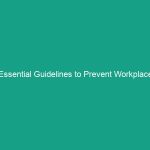Introduction
In the realm of health, safety, and Environment (HSE), the importance of implementing effective Safety Measures for high-voltage work cannot be overstated. High-voltage work encompasses a wide range of activities that involve electrical systems operating at voltages above 1,000 volts AC or 1,500 volts DC. This work is often performed in various industries including construction, utilities, and manufacturing. The potential risks associated with high-voltage operations are significant, including electrical shocks, burns, and even fatal accidents. Therefore, understanding and adhering to appropriate Safety Measures is crucial for workers and employers alike.
In this article, we will delve into the essential Safety measures for high-voltage work. We will explore regulatory frameworks, best practices, case studies, challenges, and future trends that affect the Safety of personnel engaged in high-voltage tasks. By the end of this article, readers will have a comprehensive understanding of how to mitigate risks associated with high-voltage work and foster a culture of safety in the workplace.
Regulatory Frameworks
Regulatory frameworks play a pivotal role in ensuring safety measures for high-voltage work are adhered to. These Regulations are designed to protect workers from the inherent dangers of electrical work and are often enforced by governmental bodies.
Key Regulatory Bodies
In the United States, the Occupational Safety and Health Administration (OSHA) is the primary regulatory body overseeing Workplace Safety, including high-voltage work. osha‘s Standards require employers to implement safety measures and provide Training for employees working with or near high-voltage equipment.
In Europe, the European Union has established directives that member states must follow, such as the Low Voltage Directive (LVD) and the Electricity at Work Regulations. These regulations set forth safety requirements for electrical installations and operations, ensuring that all necessary Precautions are taken to prevent Electrical Hazards.
International Standards
Beyond national regulations, international standards such as those from the International Organization for Standardization (ISO) and the International Electrotechnical Commission (IEC) provide guidelines for high-voltage safety. Standards like ISO 45001 offer a framework for Occupational Health and safety management systems, promoting a proactive approach to safety in the workplace.
By understanding and complying with these regulatory frameworks, companies can not only protect their employees but also avoid legal repercussions and enhance their reputation in the industry.
Best Practices for High-Voltage Work
Implementing Best Practices is essential for effective safety measures for high-voltage work. These practices provide a structured approach to mitigate risks and ensure that employees are adequately prepared for working with high-voltage systems.
Training and Education
One of the critical components of safety measures is comprehensive training and education for all personnel involved in high-voltage work. Workers must be trained to understand the risks they face and how to use safety equipment properly. This training should include:
- Understanding electrical Hazards and their consequences.
- Proper use of Personal Protective Equipment (PPE).
- Emergency response Procedures in the event of an electrical incident.
- Regular updates on safety protocols and changes in regulations.
Personal Protective Equipment (PPE)
Wearing appropriate PPE is non-negotiable when working with high-voltage systems. Essential PPE includes insulated gloves, flame-resistant clothing, safety helmets, and protective eyewear. Each piece of equipment should be regularly inspected and maintained to ensure its effectiveness. Workers must be trained on how to properly wear and care for their PPE to maximize protection against electrical Hazards.
Lockout/Tagout Procedures
Lockout/tagout (LOTO) procedures are critical in high-voltage work environments. These procedures prevent the accidental energization of electrical systems while Maintenance or repair work is being carried out. Implementing LOTO involves the following steps:
- Identifying all energy sources associated with the equipment.
- Shutting down equipment and isolating it from its energy source.
- Applying locks and tags to ensure that the energy source cannot be re-energized inadvertently.
- Verifying that the equipment is de-energized before commencing work.
Regular Inspections and Maintenance
Regular inspections and maintenance of electrical systems are vital for ensuring ongoing safety. This includes checking for signs of wear and tear, ensuring that equipment is functioning correctly, and replacing any faulty components. Scheduled maintenance should be documented, and findings should be reviewed to identify potential hazards before they escalate into serious incidents.
Case Studies: Lessons Learned
Examining real-world case studies can provide valuable insights into the importance of safety measures for high-voltage work. These examples not only highlight successful implementations of safety protocols but also underscore the consequences of negligence.
Case Study 1: The Power Plant Incident
In a notable incident at a power plant in the Midwest, a technician suffered severe electrical Burns due to a lack of proper lockout/tagout procedures. The technician was performing maintenance on a high-voltage transformer when the equipment was inadvertently energized. This incident led to a thorough investigation, resulting in the implementation of more stringent LOTO protocols and additional safety training for all personnel. As a result, the company saw a significant decrease in electrical incidents in the following years.
Case Study 2: Construction Site Safety
A construction site in New York faced a serious electrical accident when workers were not adequately trained to identify high-voltage lines. This oversight resulted in a worker sustaining life-threatening injuries from an electrical shock. Following this incident, the construction firm revised its safety training programs, incorporating detailed sessions on recognizing and working around high-voltage systems. This change not only improved employee awareness but also fostered a culture of safety that emphasized the importance of vigilance.
Challenges in High-Voltage Safety
Despite the existence of regulations and Best Practices, several challenges persist in ensuring safety measures for high-voltage work. Identifying and addressing these challenges is crucial for the continuous improvement of safety protocols.
Human Factors
Human error remains one of the most significant challenges in high-voltage work environments. Factors such as fatigue, distractions, and complacency can lead to lapses in judgment and increased risks. Companies must focus on creating an environment that minimizes these human factors by implementing regular breaks, encouraging communication, and fostering a safety-first mindset among employees.
Technological Advancements
While technology plays a vital role in improving safety measures, it can also introduce new challenges. As high-voltage systems become more sophisticated, workers must be trained to use advanced tools and equipment properly. Additionally, the rapid pace of technological change can make it difficult for companies to keep their training programs up to date. Ongoing education and training are essential to ensure that workers are equipped with the knowledge and skills needed to operate safely in a high-voltage environment.
Regulatory Compliance
Keeping up with regulatory changes can be a daunting task for organizations. As regulations evolve, companies must ensure that their safety protocols are aligned with the latest standards. This requires a commitment to continuous improvement and regular audits to ensure compliance. Failure to adhere to regulations can result in penalties, legal action, and, most importantly, increased risks to worker safety.
Future Trends in High-Voltage Safety
The landscape of high-voltage work is continually evolving, driven by advancements in technology and an increasing focus on safety. Understanding these trends can help organizations adapt their safety measures accordingly.
Increased Use of Automation
The integration of automation in high-voltage work has the potential to enhance safety significantly. Automated systems can perform tasks that are traditionally hazardous for human workers, reducing the risk of electrical accidents. For example, drones and robotic systems can be used for inspection and maintenance of high-voltage equipment, minimizing human exposure to dangerous situations.
Data-Driven Safety Management
The use of data analytics in safety management is gaining traction. Companies are utilizing data to identify patterns in incidents and near misses, allowing them to make informed decisions about safety protocols. By leveraging data, organizations can proactively address potential risks and improve their overall safety performance.
Enhanced Training Solutions
As technology advances, so do training methods. Virtual reality (VR) and augmented reality (AR) are emerging as effective tools for training workers in high-voltage safety. These immersive technologies allow employees to simulate high-voltage scenarios in a controlled environment, providing hands-on experience without the associated risks. This innovative approach to training can lead to better retention of safety protocols and increased preparedness for real-world situations.
Conclusion
In conclusion, implementing essential safety measures for high-voltage work is critical to safeguarding employees and ensuring a safe working environment. By understanding regulatory frameworks, adopting best practices, learning from case studies, addressing challenges, and staying informed about future trends, organizations can significantly reduce risks associated with high-voltage operations. It is the responsibility of every worker and employer to prioritize safety and foster a culture of vigilance in the workplace. Remember, when it comes to high-voltage work, prevention is always better than cure. Let’s commit to making safety our top priority.


